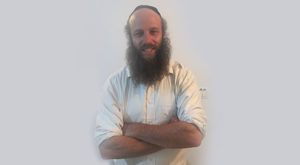Alopecia Areata
| May 4, 2021I was stunned, shaken. This couldn’t be happening to me! Was I going to lose all my hair?
I was 15 years old and getting ready for our annual student shabbaton, the highlight of the school year in Bais Yaakov of Baltimore. My friend Chaya was in middle of blow-drying my hair —
“Rivka, did you know you have a small bald spot at the back of your head?”
I shrugged her off. “Nah, it’s always been there.”
Chaya frowned. “I’ve been doing your hair for years and it has not always been there.”
I went home and showed it to my father, who told me that I’d had a bald spot in the same place when I was four but the hair had grown back.
The following week, I went for a physical and blood work. When everything came back normal, we went to a dermatologist. He took one look at the spot and made his grave pronouncement: “You have alopecia.”
I was stunned, shaken. This couldn’t be happening to me! Was I going to lose all my hair?
The doctor went on to share horror stories — the girl who lost all her hair the week of her sheva brachos, a woman who lost one eyebrow. He also gave me a small booklet about alopecia that included coping techniques. When I saw the section on bullying, I realized how lucky I am to be Jewish — I knew I would never experience any issues with my friends because of my hair loss.
Alopecia areata is an autoimmune condition in which the body sees the hair follicles as foreign bodies and attacks them, causing hair loss on some or all parts of the body. Alopecia is a polygenic disease and requires genes from both parents as well as environmental factors to trigger the condition.
For the first three months after my diagnosis, everything felt surreal. The doctor started me on oral steroids and Rogaine hair regrowth treatment, but my hair loss continued. I was diagnosed in May and went to camp in August. By the time I got back from camp, I’d lost 80 percent of my hair and was beginning to lose my eyebrows, eyelashes, and body hair. My mother took me to an amazing sheitel macher, Feige Rosen, who specializes in wigs for people with cancer and other hair loss conditions. She helped me find and cut a wig to look like my hair. When I turned to show my mother my new look, she started crying. Throughout my years in high school, Feige treated me like her daughter and made me feel like a princess.
I started tenth grade with new glasses — and my new wig. I tried really hard to hold my head up and ignore the stares of the girls trying to figure out what was different about me. After a few days, my principal called my parents and told them that girls were concerned that I was sick; he suggested that the dermatologist come to explain my condition to them. I told my parents I wasn’t going to be a nebach case and I would speak to my classmates myself. When I shared my story, I saw only admiration and full support in the eyes of my classmates.
I made a decision then that no matter what I was going through inside, I was going to put on a good face to the world and get through the challenge. The support of my amazing family who accepted me for me and stood by me was my rock. My friends and teachers also helped me through those rough years.
I spent a lot of time talking to myself in the mirror and learning to love the new me. A girl’s hair and appearance are a huge part of her identity. I went to therapy and cried a lot. I’d lost a piece of myself, and I needed to mourn it before I could rebuild.
Throughout high school, I seemed to be living on two planes. On one level, I tried different treatments and kept hoping that my hair would come back. (With alopecia, the hair follicles remain alive, and regrowth can happen at any time.) On another level, I needed to accept the possibility that my hair might never come back.
I did many treatments over the years (both medical and holistic), but none induced significant growth. When I took steroids for a different medical issue, those did induce full growth — but my hair fell out again as soon as I went off. Steroids aren’t a long-term solution.
While in shidduchim, I got redt a lot of boys with “issues.” The shadchan’s rationale was obvious: “He’s got a problem, she’s got a problem, let’s make a shidduch!”
My parents stood firm in their conviction that I was normal and would marry someone normal who would appreciate me for me. When I met my husband, I really felt like he was seeing me for me, and not my external appearance. It had been a struggle for me to truly believe that someone else could see me as beautiful and unconditionally love me for me. Getting married was the ultimate closure; finally, I was able to believe that I was a beautiful person inside and out.
Honestly, once I was married, 80 percent of my teenage struggles with alopecia took a back seat in my life. When I’d been diagnosed, I called a woman in her fifties who had alopecia, hoping for guidance, but she had nothing to tell me. It seemed as if the alopecia had faded into the background of her life. I didn’t understand her then, but now I do. Once I was married, I finally looked like everyone else in my sheitel and tichels.
When I was diagnosed 19 years ago, it was hard for me to imagine that one day alopecia wouldn’t take center stage in my life. My condition was always on my mind. Today, I rarely think about the fact that I don’t have hair.
I told each of my children about my hair loss at a very young age, asking them, “Does Mommy have any hair?” They would often say yes, and then I would gently correct them. “See, no, Mommy doesn’t have hair and it’s okay. I have a hair-loss condition.” They would look at me with the unconditional love of a child to his mother and that would be that.
Recently, my seven-year-old asked me if she can tell her friend that her mommy doesn’t have any hair. I told her she could. It doesn’t make me less of a person if her friends know about alopecia. All it does is empower my children to internalize that people have challenges and can still live normal, healthy, and full lives.
I’m trying to teach my kids that you need to accept what is and who you are. Because your outer body is just a reflection of the inner you.
Please Don't:
-Ask if someone is married, or why they’re wearing a wig. I once was at a vort when I was a teenager, and someone asked me if I was Rabbi Roll’s wife. When I told her I was his daughter, she asked me, “Are you wearing a sheitel?” I ran out of the room in tears. At other times, people would ask me when I got married — or when I’d divorced.
-Stare at someone who looks different. It’s human nature to do so, but it’s still hurtful. I used to have people stare at me all the time, and I’ve learned to just stare back. I always tell my kids that people look when something is different, but after a minute they forget about it and go back to their own lives.
-Ask tactless questions. If you’re really desperate to know what someone’s going through, ask their friend or relative.
Please do:
-Send a kind note, a small gift, or tell someone how they’ve inspired you. It shows them their daily struggle was noticed. I remember a 12th grader who sent me a note shortly after my diagnosis to tell me how much she admired my strength. Many people wrote me notes over the years that gave me so much chizuk — and I still have all of them today.
-Offer practical help. One of my amazing teachers taught me how to use makeup and stencils to do my eyebrows, which I did on and off throughout high school (and daily when I was dating).
-Offer support and validate pain. I’ll never forget the mentor who told me, “It’s okay to cry and feel the pain. Accept it and build yourself from it.” Her words gave me so much strength.
I’ll never forget:
-During the opening school trip in tenth grade, ten of my friends wore baseball caps with me so that I could go without wearing a wig and without feeling like I stood out. The support of good friends and neighbors is key in getting kids through this challenge.
I can be contacted for guidance and support through Family First.
(Originally featured in Family First, Issue 741)
Oops! We could not locate your form.








